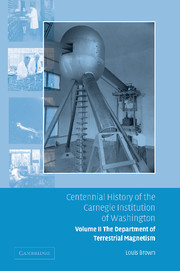Book contents
- Frontmatter
- Contents
- Foreword by Richard A. Meserve
- Preface
- 1 Establishment
- 2 Cruises and war
- 3 Expeditions
- 4 Measurements: magnetic and electric
- 5 The Fleming transition
- 6 The last cruise
- 7 The magnetic observatories and final land observations
- 8 The ionosphere
- 9 Collaboration and evaluation
- 10 The Tesla coil
- 11 The Van de Graaff accelerator
- 12 The nuclear force
- 13 Fission
- 14 Cosmic rays
- 15 The proximity fuze and the war effort
- 16 The Tuve transition
- 17 Postwar nuclear physics
- 18 The cyclotron
- 19 Biophysics
- 20 Explosion seismology
- 21 Isotope geology
- 22 Radio astronomy
- 23 Image tubes
- 24 Computers
- 25 Earthquake seismology
- 26 Strainmeters
- 27 The Bolton and Wetherill years
- 28 Astronomy
- 29 The solar system
- 30 Geochemistry
- 31 Island-arc volcanoes
- 32 Seismology revisited
- 33 Geochemistry and cosmochemistry
- 34 The Solomon transition
- 35 The support staff
- 36 Epilogue
- Notes
- Index
33 - Geochemistry and cosmochemistry
Published online by Cambridge University Press: 06 January 2010
- Frontmatter
- Contents
- Foreword by Richard A. Meserve
- Preface
- 1 Establishment
- 2 Cruises and war
- 3 Expeditions
- 4 Measurements: magnetic and electric
- 5 The Fleming transition
- 6 The last cruise
- 7 The magnetic observatories and final land observations
- 8 The ionosphere
- 9 Collaboration and evaluation
- 10 The Tesla coil
- 11 The Van de Graaff accelerator
- 12 The nuclear force
- 13 Fission
- 14 Cosmic rays
- 15 The proximity fuze and the war effort
- 16 The Tuve transition
- 17 Postwar nuclear physics
- 18 The cyclotron
- 19 Biophysics
- 20 Explosion seismology
- 21 Isotope geology
- 22 Radio astronomy
- 23 Image tubes
- 24 Computers
- 25 Earthquake seismology
- 26 Strainmeters
- 27 The Bolton and Wetherill years
- 28 Astronomy
- 29 The solar system
- 30 Geochemistry
- 31 Island-arc volcanoes
- 32 Seismology revisited
- 33 Geochemistry and cosmochemistry
- 34 The Solomon transition
- 35 The support staff
- 36 Epilogue
- Notes
- Index
Summary
The periodic table has a number of radioactive parent–daughter isotopes with half lives useful for geochronology or geochemistry studies, but for many years only those susceptible to thermal ionization were of use. All elements can be ionized and therefore given over to mass analysis, but constraints apply. For most of this kind of work the elements of interest are present in relatively small concentrations, requiring an efficient ionization process, if reasonable amounts of sample are to be employed. The thermal method has much higher efficiency than electron bombardment and does not require the complication of electrostatic energy analysis needed for most other methods of ionization. For many years these observational restrictions had limited analysis to samples containing the radioactive elements potassium, rubidium, samarium, thorium and uranium; oxygen relied on electron bombardment but was present in abundant amounts, even in small samples.
An isotope pair that had long intrigued those in the field was the beta decay of 187Re into 187Os, having a half life about the same as 87Rb. Little thought was given to using the pair because both isotopes are refractory elements from which it is impossible to form positive ions thermally, as they are hungry to bind electrons, not to give them up. In 1986 a research effort at the National Bureau of Standards by John D. Fassett to develop a selective technique of laser ionization that succeeded in ionizing the Re/Os pair, work done with DTM research associate Richard J. Walker, found it possible to obtain ratios to an accuracy of 1%, yielding useful geological data for samples rich in the parent isotope.
- Type
- Chapter
- Information
- Centennial History of the Carnegie Institution of Washington , pp. 245 - 252Publisher: Cambridge University PressPrint publication year: 2005



